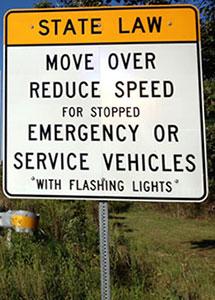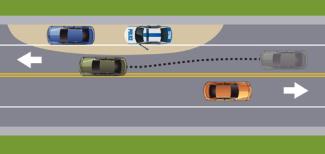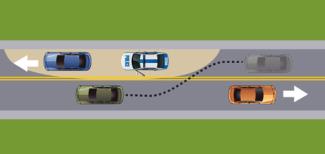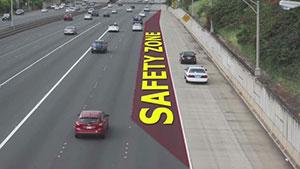Motor Vehicle Laws
What is the "Move Over" Law?
The "Move Over" law was designed to protect those who drive emergency and other designated vehicles. The law requires drivers to slow down and move over when approaching a designated vehicle that is stopped in a lane or on the edge/shoulder of a roadway.
This law is in addition to the law that requires drivers to pull over to the side or otherwise yield the right of way when an emergency vehicle (police, fire, ambulance) is approaching with their lights and sirens activated.
When does this law apply?
The "Move Over" law applies when a designated vehicle is stopped and operating its red, blue or amber lights or has other traffic warning signals displayed.

Designated vehicles include:
- police
- fire
- ambulance
- tow truck/roadside assistance
- public utility vehicles and/or service vehicles
- highway maintenance vehicles and/or equipment
- transporter trucks
All vehicles must be equipped with and operating flashing red, blue or amber lights.
By slowing down and moving over, you will increase the safety of those workers as they perform their duties and reduce the risk of being hit by a vehicle.
On a Multi-Lane Roadway:
If you are driving on an interstate or roadway with multiple lanes of travel in the same direction and approach a designated vehicle with lights flashing parked on the side of the road, you must move over by changing lanes away from the designated vehicle as soon as it is safe to do so. If you are not able to safely move over, you must slow down. Leave as much distance as possible between you and the designated vehicle as possible.
On a Two-Lane Roadway:
On a two-lane roadway, you are required to slow down. Leave as much distance between you and the designated vehicle as possible.
"Move Over" visuals
The general rule is to create a buffer lane by slowing down and putting as much distance as possible between you and the stopped vehicle.
Vehicle on the shoulder in a double lane

Where there is another lane going in the same direction, and only if it is safe to do so, slow down and change lanes so that there is a full lane between you and the designated vehicle.
Vehicle on the shoulder in a single lane

If a lane change is not possible, remain in the lane you are traveling but put as much distance as possible between you and the designated vehicle.
Vehicle in a single lane

Slow down and change lanes, but only if it's safe to do so. You must yield to on-coming traffic or traffic in the other lane. Otherwise, stop your vehicle and wait until you can safely proceed. You should only pass a designated vehicle if it is safe to do so.
Vehicle in a double lane

Change lanes if there is another lane for traveling in the same direction, or otherwise place as much distance as safely possible between your vehicle and the designated vehicle.
Images courtesy of Government of Newfoundland and Labrador, Canada
Failure to Move Over
Failure to move over may result in a citation and a fine. More seriously, you could crash into the designated vehicle or strike an individual, causing serious injury or death to another person or yourself.
View the statute in the Rhode Island General Laws

10 Least Known Motor Vehicle Laws
- Don't drive your car with any significant amount of snow or ice on it. Significant is construed as any amount of accumulation that might reasonably be expected to blow off the vehicle and obscure the vision of another operator. (R.I.G.L. § 31-23-16)
- It is against R.I. law to drive a vehicle or a bicycle while wearing earphones or a headset. This refers to music, not to cellular phones. (R.I.G.L. § 31-23-51)
- Turn on your interior light if you are stopped by the police. R.I. law requires you to turn on your dome light when stopped between one-half hour after sunset and one-half hour before sunrise. This is for the safety of the police officer. (R.I.G.L. § 31-22-24)
- If the weather is such that you need your wipers, you also need your headlights. Turn them on when your wipers are in use due to rain, sleet, snow, hail or other unfavorable atmospheric conditions, or at any other time when there is not sufficient light or visibility. (R.I.G.L. § 31-24-1)
- Don't enter an intersection until you can clear it. If traffic is such that when you enter an intersection you cannot pass through that intersection, then don't! Wait until there is enough clearance for your vehicle to completely pass through the intersection before going. (R.I.G.L. § 31-16-2)
- Inspect a vehicle purchased out of state. If you purchased a vehicle out of state, it must be inspected by a R.I. inspection station within five days of registering the vehicle. (R.I.G.L. § 31-38-5)
- Notify the Division of Motor Vehicles of your change of name or address. Whenever you change your name or address, you must notify the Registry, in writing, within 10 days of the change. (R.I.G.L. § 31-3-34 & 31-3-35)
- Your registration plates must be visible. Your places must be visible from a distance of 100 feet during daylight. Plastic plate cover, whether colored or not, make this impossible. Also, your plate is required to be displayed in a certain location; displaying it in a back window or front windshield is not allowed. At night, the rear plate must be illuminated. (R.I.G.L. § 31-3-18 & 31-24-9)
- Restrain your pet. If your pet is being transported in an open-air vehicle (i.e. pickup truck), it must be restrained with a harness manufactured for the purpose of restraining animals by means other than neck restraints. (R.I.G.L. § 31-22-28)
- Aftermarket window tint is strictly prohibited. Any tint that is applied to a vehicle window must be in compliance with specific opacity standards. Any tint that is in the form of a sticker and applied to a window is prohibited. (R.I.G.L. § 31-23.3-2)
